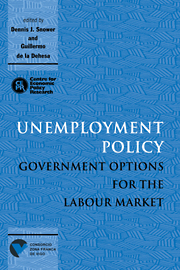Book contents
- Frontmatter
- Contents
- List of figures
- List of tables
- Preface
- Acknowledgements
- List of conference participants
- 1 Introduction
- PART ONE GENERAL POLICY ISSUES
- PART TWO DEMAND MANAGEMENT AND SUPPLY-SIDE POLICY
- PART THREE SUBSIDISING EMPLOYMENT AND TRAINING
- PART FOUR LABOUR MARKET REGULATIONS
- PART FIVE POLICY, JOB REALLOCATION AND THE UNEMPLOYMENT–PRODUCTIVITY RELATION
- PART SIX COMPARING UNEMPLOYMENT POLICIES
- 16 Unemployment in the OECD and its remedies
- Discussion
- Discussion
- 17 The unemployment and welfare effects of labour market policy: a comparison of the USA and the UK
- Discussion
- Discussion
- Index
16 - Unemployment in the OECD and its remedies
Published online by Cambridge University Press: 07 September 2010
- Frontmatter
- Contents
- List of figures
- List of tables
- Preface
- Acknowledgements
- List of conference participants
- 1 Introduction
- PART ONE GENERAL POLICY ISSUES
- PART TWO DEMAND MANAGEMENT AND SUPPLY-SIDE POLICY
- PART THREE SUBSIDISING EMPLOYMENT AND TRAINING
- PART FOUR LABOUR MARKET REGULATIONS
- PART FIVE POLICY, JOB REALLOCATION AND THE UNEMPLOYMENT–PRODUCTIVITY RELATION
- PART SIX COMPARING UNEMPLOYMENT POLICIES
- 16 Unemployment in the OECD and its remedies
- Discussion
- Discussion
- 17 The unemployment and welfare effects of labour market policy: a comparison of the USA and the UK
- Discussion
- Discussion
- Index
Summary
There is evidence today of dramatic changes in the labour market as a result of competition between low-wage ‘emerging-market’ economies and the rich OECD countries. In previous work I and others (for example, Bean, Layard and Nickell, 1986; Davis and Minford, 1986; Layard and Nickell, 1985; Minford, 1983; and see Layard, Nickell and Jackman, 1991, for other relevant work) have explored how far one can account for changing unemployment in the OECD through general equilibrium models of the open economy. These models have used conventional ‘elasticities’ equations for the current account, assuming that the prevailing competition facing OECD countries was imperfect competition in manufactures from other OECD countries.
Such models have given fairly plausible results to date. The story they have told has also been qualitatively persuasive. In summary, it has identified the basic cause of high unemployment as long-duration unemployment benefits or equivalent social support. Given such a source of ‘real wage rigidity’ all sorts of developments whose effect would under flexible wages be to lower real wages have the effect of causing unemployment. It is possible to estimate the ‘natural rate’ of unemployment within such models, as the equilibrium once macroeconomic shocks to demand have died away. Theories of ‘efficiency wages’ are really, for all the claims one finds for them as a ‘general’ theory of unemployment (e.g. Phelps, 1994), merely one special development of the sort just described: if the ‘outsiders’ do not exhibit real wage rigidity then the fall in outsider real wages would displace downwards the comparator for insiders and the whole wage structure would be flexible.
- Type
- Chapter
- Information
- Unemployment PolicyGovernment Options for the Labour Market, pp. 501 - 533Publisher: Cambridge University PressPrint publication year: 1997



